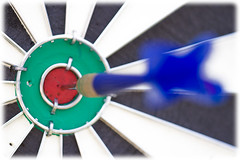If you don’t already know, a landing page is a special sort of page on your web site. It’s a page designed for one thing, and one thing only – to generate action. This could be a sale, a newsletter signup, or a lead generation form.
Here’s how to write a landing page that converts.
In order for your landing page to work, you’ll need these ten essential components.
1. A great headline
The headline pulls people in and tells them that there’s something on the rest of the page that they will be interested in reading. It promises to solve a problem, help them learn something, save money, or perform better. It’s the most important part of the page – blow the headline and you’re sunk. Luckily, there are some proven ways to write great headlines.
2. Testimonials
This is proof from other people that what you’re selling or offering really works. It’s called social proof. It helps you build credibility online (or off) with people who don’t know you. Include full names (Bob L., from Kansas isn’t very reassuring), and a photo (if you can). The testimonials should be as specific as possible. For instance, “My teeth used to be dull and yellow, but after using Dr. Rick’s super-bright smile booster for one week, they’re now dazzling white and beautiful.”
3. A photo of the product
People like to see what they’re getting. Put in a picture. If it’s an e-product, create a representation of it (such as a book or a CD).
4. Ask for one thing
And one thing only. Don’t try to get a newsletter signup, a tweet, and an ebook purchase all on the same page. Even if it’s something that’s going to be in front of lots of people. You’ll just confuse people. You’ll also dilute the response you get, as it will be spread out among two or three things. And make sure it’s absolutely clear what you want them to do. Make it a big red button.
5. State the benefits
Tell your readers what they’ll get. You made the promise in the headline, now explain how it works. What results will they get? What problem does it solve? How long does it take?
6. Sub-headings
It’s tough to read a big block of text (especially online). Plus, there are two ways people read. Some read every word, many just skim the headlines and sub-heads – and then stop to read the full paragraph when they find something interesting. Allow for both.
7. Multiple order buttons
People click more when there’s more than one button – even if it goes to the same place. Use two or three and distribute them throughout the page(depending on how long your page is) .
8. A big, fat guarantee
Stand by your work. Offer a money-back guarantee. This is another way to show credibility – you’re so sure that your product will work, that you’re willing to risk a refund. You’ll actually make more sales with a refund.
9. A value statement
Explain how much the product(s) are worth, compared to the actual price. If it’s an e-book, compare it to your hourly consulting rate. Or several products (sold separately) to the price of one product.
10. A thank you
After someone fills out your form, or buys your product, thank them. You might also suggest they do something else, such as read your blog. Or, explain what will happen next – whether someone will call them, or how the rest of the delivery process for the e-book works. Besides, it’s polite.

